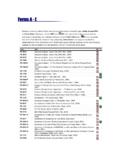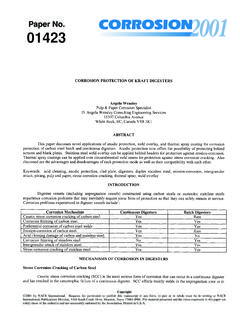Transcription of AN OVERVIEW OF LIME SLAKING AND FACTORS …
1 1 AN OVERVIEW OF LIME SLAKING AND FACTORS THAT AFFECT THE PROCESS By: Mohamad Hassibi Chemco Systems, November 1999 Revised: November 2015 ABSTRACT Since lime SLAKING is an integral part of treatment systems in water, wastewater, air pollution, and process industries its performance will influence the overall effectiveness of the process as well as operating costs. This paper reviewr FACTORS that affect efficiency and performance of lime SLAKING systems. INTRODUCTION Research on lime SLAKING has been done on a limited basis in recent years. Most of this research has been done under auspices of the National Lime Association. The information presented in this paper builds upon the research done by others and the author s years of hands on experience in lime SLAKING . Because limestone is a naturally occurring mineral its chemical composition and physical characteristics change not only from area to area but within veins of limestone in the same area.
2 This variation in raw mineral results in variation of the quality of the calcium oxide produced from this limestone. The use of lime in its various forms has been steadily on the rise with no end in site. Today lime is the most important chemical used throughout the world for pollution control. It is, therefore, imperative that handling and processing lime be well understood by all those who use this chemical. LIME MANUFACTURING AND LIME SLAKING PROCESS Limestone or calcium carbonate (CaCO3) exists as a natural stone throughout the world. Limestone in its natural form is very slow reacting, therefore, it has a limited use. The most significant use of pulverized limestone is in agriculture and finely ground in flue gas desulphurization in slurry from. In this paper we will concentrate on calcium oxide and calcium hydroxide.
3 In most pollution control applications lime is used as calcium hydroxide. To manufacture calcium hydroxide the limestone, calcium carbonate, must be converted to calcium oxide and the calcium oxide then converted to calcium hydroxide. The following are the chemical formulas of this process: 2 (Limestone) CaCO3 + HEAT (Calcium Oxide) CaO + CO2 However CaO is unstable in the presence of moisture and CO2. A more stable form of lime is calcium hydroxide Ca(OH)2. (Calcium Oxide) CaO + (Water) H2O Calcium Hydroxide Ca(OH)2 + HEAT The atomic weight of the above formula is: Ca= 40 O= 16 H= 1 (40+16) + (2+16) = 74 56 + 18 = 74 Therefore, 56 units of CaO plus 18 units of H2O results in 74 units of Ca(OH)2. The ratio of hydroxide to CaO is 74 56= This means that 1 Kg of CaO and Kg of water will produce Kg of Ca(OH)2, this is the minimum water required for chemical reaction, so calcium hydroxide contains CaO and H2O.
4 The process of adding water to calcium oxide to produce calcium hydroxide is referred to as hydration process or lime SLAKING . The hydration of CaO, commercially referred to as quick lime, is an exothermic process releasing a great quantity of heat. This hydration process when done with just the right amount of water for chemical reaction is called Dry Hydration. In this case the hydrate material is a dry powder. If excess water is used for hydration, the process is called SLAKING . In this case the resultant hydrate is in a slurry form. Lime manufacturers generally use the dry hydration process for producing powdered hydrated lime. Our discussion here is limited to the lime SLAKING . The SLAKING process is normally done with considerable excess water ranging from 2 parts water to 1 part CaO to 6 parts water to 1 part CaO.
5 EQUIPMENT USED FOR THE SLAKING PROCESS It is not the intent of this paper to evaluate the SLAKING equipment described below. The intent is to show the types of equipment available for SLAKING process. There are basically three types of lime slakers available on the market. They are: A. Slurry Detention Slakers B. Paste Slakers C. Ball Mill Slakers A slaker must mix the correct amount of quick lime (CaO) and water, hydrate the quicklime, and separate the impurities and grit from resultant calcium hydroxide slurry. 3 A. SLURRY DETENTION SLAKERS A slurry slaker generally uses an initial lime to water ratio of 1 to to 1 to 5 depending on the make of equipment and quality of CaO and water. Typically a slurry slaker, sometimes called a detention type slaker, is comprised of two chambers. The first chamber is called the SLAKING chamber where lime and water are mixed.
6 The second chamber is usually used as a grit removal chamber. The lime slurry flows by gravity from the first chamber to the grit chamber. The slurry viscosity is reduced in the second chamber by addition of cold water to dilute the slurry and allow the heavier grit to settle to the bottom of the second chamber, where the grit is elevated and discharged by a screw. Figure 1 shows one such slaker. The slurry slakers are generally designed for a retention time of 10 minutes at full rated capacity. This means that a particle of CaO from the time it enters the slaker until it exits into the grit remover takes an average of 10 minutes. Figure 1 The slurry slakers are available in a variety of sizes ranging from 150lb/hr to 25 tons/hr. Slurry slakers also are available with external vibratory grit separation screens.
7 Slurry or detention types slakers are the most common types in Europe and the USA. Grit Discharge Lime Slurry Volumetric Rotary Feeder Sample Chute Grit Remover Chamber Slurry Discharge Heat Exchanger Dust and Vapor Canister Figure 1. Typical Slaker Flow Pattern. 4 B. PASTE SLAKERS Paste slakers, as the name implies, slake the lime in a paste form. The lime to water ratio is generally 1 to Paste slakers are compact in size and are designed for a retention time of 5 minutes in the SLAKING chamber. In a paste slaker, since the hydroxide paste is too heavy to flow by gravity, a pair of horizontal rotating paddles push the paste forward toward the discharge point. Once the paste exits the SLAKING chamber it is diluted to approximately 1 part hydrated lime to 5 parts water. This dilution allows grit separation by gravity or by an external vibrating grit screen.
8 The slurry consistency from a paste slaker and a slurry slaker is exactly the same after dilution for grit removal. Paste slakers are available in sizes ranging from 1000lb/hr to 8000lb/hr. Paste slakers are mostly used in the USA. Figure 2 is a graphic depiction of a paste slaker. The grit separator is not shown in this figure. Figure 2 Weir SLAKING Discharge Chamber Over Flow Pipe Motor Vent Slaked Lime (Slurry) Discharge Gearbox SLAKING Chamber Lime Feed Cut-off spray Header 5 C. ATTRITOR VERTICAL BALL MILL SLAKERS The Attritor Ball mill is an adaptation of ball mills, which originally were designed for wet and dry grinding, to the job of SLAKING . Ball mill slakers are generally used when due to zero discharge conditions at the site no grit discharge is allowed. The ball mill slakers are more expensive than paste or slurry slakers.
9 They are available in sizes ranging from 1000lb/hr to 25 tons/hr. Figure 3 shows an attritor type vertical ball mill lime slaker. The ball mill slakers are equipped with an external classifier hydrocyclones, which separates slurry from the oversized grit and impurities. The oversize grit is recycled back into the mill for regrind. Figure 3 6 D. BATCH SLAKER Batch sl akers are a variation of the slurry slaker. They typically work as follows: As the name implies, the operator decides the si ze of the batch of lime sl urry to be made. The co ntrols using the desired batch set point calculate how much water and lime is needed to make one batch. First, the cold water in a predetermined quantity (volumetrically or gravi metrically) is added to the batch tank. Then the quicklime is added in a predetermined quantity (volumetrically or gravimetrically) to the batch tank.
10 The lime and water are mixed and agitated until the mixture s temperature reaches a preset temperature between 175 F to 185 F. Once the desired temperature is reached, the resultant sl urry is dumped into a second tank for use or grit removal depending on whether a pulverized or pebble quicklime is used. Once the sl aking tank is emptied, the water for the next batch is added to the sl aking tank and the system goes to a stand-by mode waiting for an operator to st art the next batch cycle. Figure 4 shows a batch sl aker for use with pulverized quicklime. Batch sl akers are used where only a few small batches are needed periodically when a continuous sl urry sl ake r cannot be used. Figure 4 7 FACTORS AFFECTING QUALITY OF CaO As stated previously the calcium carbonate is heated in the rotary or vertical kilns to drive away CO2 from limestone, CaCO3, to produce calcium oxide CaO.




